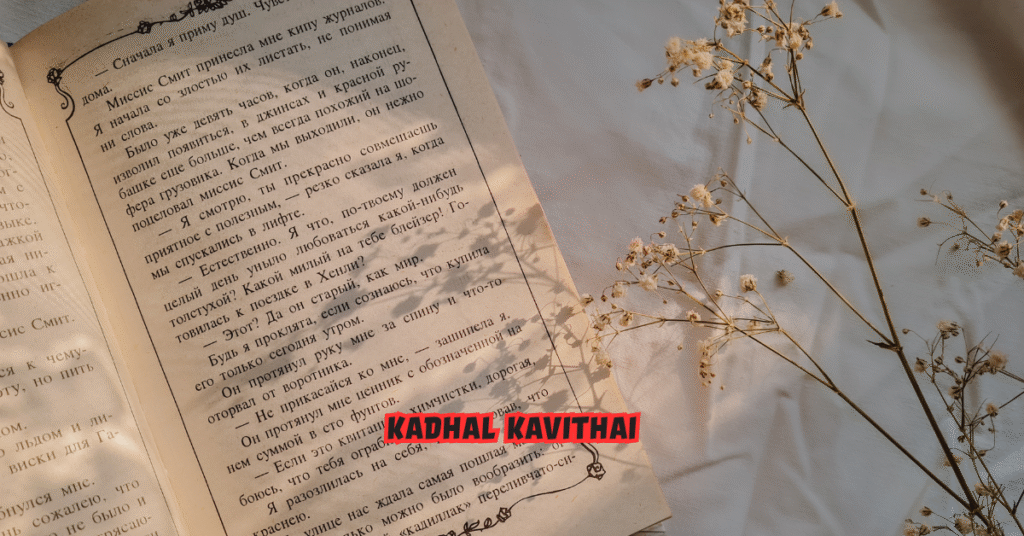Kadhal Kavithai’s, a Tamil term meaning “love poetry,” represents one of the most profound forms of literary expression in South Indian culture. It is not just about words written in rhyme but an art form that weaves together emotions, cultural traditions, and human experiences. For centuries, Tamil poets have used poetry as a way to express love in all its shades—joyful, painful, spiritual, and eternal. While classical Tamil literature, such as Sangam poetry, captured romance and longing, modern Kadhal Kavithai’s has evolved into a diverse style, merging contemporary emotions with age-old traditions. Today, these poems are not limited to books or oral recitals but are widely shared across social media, celebrated in Tamil cinema, and even incorporated into wedding vows and love letters.
For those curious about Kadhal Kavithai’s, this guide provides everything—its meaning, history, themes, influence on Tamil culture, examples, and how it continues to thrive in the modern age. By the end, you will have a deeper understanding of how love poems transcend mere words, becoming reflections of human desire and connection.
What is Kadhal Kavithai?
Kadhal Kavithai literally translates to “love poem” in Tamil. At its essence, it is an emotional composition that conveys feelings of affection, desire, longing, heartbreak, or admiration. Unlike straightforward prose, poetry allows emotions to be intensified through metaphors, similes, rhythm, and imagery.
The significance of Kadhal Kavithai’s lies in its ability to connect individuals on a deeply personal level. Whether whispered privately, performed publicly, or written as part of Tamil literature, it captures the universal emotion of love in a culturally specific yet timeless manner.
Historical Background of Kadhal Kavithai
Tamil literature has one of the oldest poetic traditions in the world, dating back over two millennia. The Sangam era (around 500 BCE to 300 CE) produced a rich body of poetry, much of which centered on love and human relationships. These early works, categorized as Akam poetry, explored love through various stages—first meeting, secret unions, separation, waiting, and reunion.
Over the centuries, Kadhal Kavithai continued to flourish in temple poetry, devotional literature, and courtly writings. The Bhakti movement also influenced the expression of love, often blurring the lines between divine and romantic affection.
In the modern period, especially during the 20th century, Tamil cinema popularized love poetry. Filmmakers used lyrical verses in songs to express emotions that went beyond dialogue, making Kadhal Kavithai’s accessible to mass audiences. Today, these verses continue to inspire not only films but also everyday communication in love letters, text messages, and social media captions.
Themes in Kadhal Kavithai
Love poetry in Tamil often follows recurring themes, reflecting universal experiences. Some of the most prominent include:
- First Love – The excitement and nervousness of discovering affection for the first time.
- Separation and Longing – Expressing pain, distance, and yearning for a loved one.
- Devotion and Commitment – Love as a lifelong bond of loyalty and sacrifice.
- Unfulfilled Love – The beauty and tragedy of desires that cannot be realized.
- Nature as Metaphor – Using rivers, flowers, rain, and stars to represent emotions.
- Spiritual Love – Comparing romantic love with divine union.
Table: Classical vs. Modern Kadhal Kavithai
| Aspect | Classical Kadhal Kavithai (Sangam Era) | Modern Kadhal Kavithai (Contemporary) |
|---|---|---|
| Language Style | Highly symbolic and nature-based | Direct, expressive, and simple |
| Themes | Love, longing, reunion, divine union | Romance, heartbreak, digital love |
| Medium | Oral recitals, manuscripts | Songs, social media, blogs |
| Audience | Royal courts, literati, small circles | Global audience, youth, general public |
| Influence | Philosophy, devotion, community life | Cinema, pop culture, personal emotion |
Influence of Kadhal Kavithai in Tamil Cinema
Tamil cinema has been one of the greatest vehicles for the spread of Kadhal Kavithai. Almost every generation of filmmakers has used poetic lyrics to give depth to romantic storytelling. Lyricists like Kannadasan, Vairamuthu, and Na. Muthukumar transformed the emotional landscapes of movies by embedding profound verses within songs.
For instance, in the film Kadhal Kavithai‘s (1998), the very title highlighted the role of poetry in love stories. Through cinema, these poems reached people who may never read a classical text but could feel the beauty of poetry in a song. Social media platforms now amplify this reach, where snippets of poetic verses from movies are shared widely, often becoming cultural catchphrases.
The Art of Writing Kadhal Kavithai
Writing Kadhal Kavithai is not simply about rhyming words but requires an emotional depth and cultural sensitivity. Writers often start with a personal feeling—whether admiration, longing, or sadness—and then use imagery to elevate it into a poetic form. A few techniques commonly used include:
- Metaphors: Comparing love to natural elements like rain, moonlight, or flowers.
- Repetition: Using rhythmic repetition to enhance emotion.
- Contrast: Juxtaposing joy with sorrow, closeness with distance.
- Symbolism: Employing birds, rivers, and landscapes to represent human experiences.
Table: Key Symbols in Kadhal Kavithai and Their Meanings
| Symbol | Meaning in Poetry |
|---|---|
| Moon | Eternal love, beauty, longing |
| River | Flow of emotions, separation |
| Lotus | Purity, divine affection |
| Rain | Renewal, passionate desire |
| Star | Hope, distant love |
| Fire | Burning passion, intensity |
Kadhal Kavithai in Daily Life
In Tamil communities, love poems are not confined to literature alone. They are recited at weddings, written in greeting cards, and quoted in proposals. Young people often exchange short poetic verses as text messages, while older generations still remember lines from Sangam poems. Social media has made Kadhal Kavithai a trending form of self-expression, where people use it as captions for photos, statuses, and reels.
Interestingly, Kadhal Kavithai’s is also used in education, as students learn about classical Tamil through poetry. This dual role—personal and academic—has ensured that the tradition continues to be passed down through generations.
Why Kadhal Kavithai Still Matters Today
In a fast-paced digital world, love poetry serves as a reminder that human emotions remain constant, regardless of time. Kadhal Kavithai continues to matter because it connects people to their roots while allowing them to express contemporary feelings. As one poet once said, “Poetry does not change the world, but it changes the way the heart beats.”
Kadhal Kavithai plays a vital role in Tamil identity, offering both personal comfort and collective cultural pride. Its survival across centuries proves its timeless relevance.
FAQs about Kadhal Kavithai
1. What does Kadhal Kavithai mean in English?
Kadhal Kavithai translates to “love poem” in English. It refers to Tamil poetry that expresses emotions of romance, longing, and affection.
2. Is Kadhal Kavithai only part of classical literature?
No, while its roots go back to Sangam literature, Kadhal Kavithai continues to thrive in modern cinema, social media, and personal writing.
3. Can non-Tamil speakers understand Kadhal Kavithai?
Yes, many translations exist, and the universal emotion of love makes these poems accessible even when not read in Tamil.
4. How can someone start writing Kadhal Kavithai?
Begin with a personal emotion and use simple imagery like nature or everyday life. Read classical and modern examples for inspiration.
5. Why is Kadhal Kavithai important in Tamil culture?
It reflects not only personal emotions but also collective traditions. It has historical, cultural, and social significance, connecting generations.
Conclusion
Kadhal Kavithai stands as one of the most powerful traditions in Tamil literature and culture. From the ancient Sangam poems to modern-day movie lyrics and Instagram captions, it continues to evolve without losing its essence. It captures the tenderness of first love, the agony of longing, the beauty of nature, and the devotion of commitment.
Through symbolism, metaphors, and lyrical expression, it speaks to the deepest layers of the human heart. Kadhal Kavithai matters not just because it is an art form but because it is a shared cultural memory that continues to bring people together. In a world that often feels fragmented, love poetry offers unity through emotion.
As one Tamil poet beautifully expressed, “Love is not a word we write, but a song we live.” Kadhal Kavithai’s will continue to live on as long as hearts yearn to be understood, cherished, and remembered.







